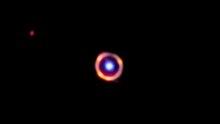Einstein ring
[1] Instead of light from a source traveling in a straight line (in three dimensions), it is bent by the presence of a massive body, which distorts spacetime.
An Einstein Ring is a special case of gravitational lensing, caused by the exact alignment of the source, lens, and observer.
The bending of light by a gravitational body was predicted by Albert Einstein in 1912, a few years before the publication of general relativity in 1916 (Renn et al. 1997).
[5] Einstein remarked upon this effect in 1936 in a paper prompted by a letter by a Czech engineer, R W Mandl,[6] but stated Of course, there is no hope of observing this phenomenon directly.
The first complete Einstein ring, designated B1938+666, was discovered by collaboration between astronomers at the University of Manchester and NASA's Hubble Space Telescope in 1998.
The first complete Einstein ring to be discovered was B1938+666, which was found by King et al. (1998) via optical follow-up with the Hubble Space Telescope of a gravitational lens imaged with MERLIN.
[23][24] In September 2023, a scientist named Bruno Altieri saw a hint of an Einstein ring in the data coming back from the Euclid space telescope.
[26] In February 2025, the Euclid space telescope captured a nearly perfect Einstein ring around galaxy NGC 6505, about 590 million light-years away.
[27] Using the Hubble Space Telescope, a double ring has been found by Raphael Gavazzi of the STScI and Tommaso Treu of the University of California, Santa Barbara.
[28] Below in the Gallery section is a simulation depicting a zoom on a Schwarzschild black hole in the plane of the Milky Way between us and the centre of the galaxy.
The zoom then reveals a series of 4 extra rings, increasingly thinner and closer to the black hole shadow.




